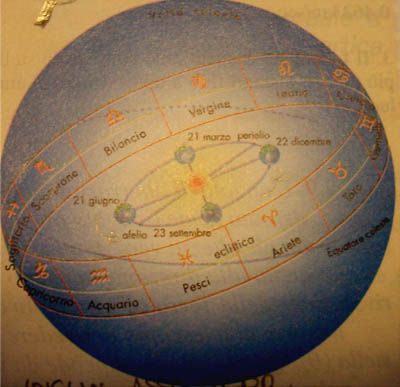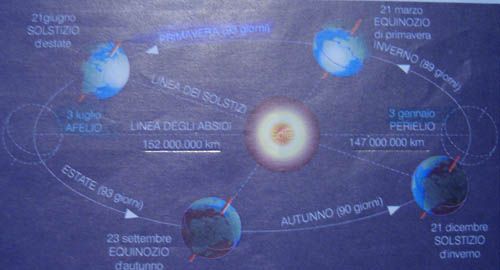revolution, the movement that makes the earth rotating around the sun. To do a full circle the Earth Impega a year.
There is a point of the orbit where the Earth is closest to the sun, it is the perihelion, where the land currently passes on Jan. 3. The earth-sun distance at perihelion is 147 million kilometers. The point of greatest distance between Earth and Sun is that instead aphelion, and is reached on July 3, at this point the distance between Earth and Sun is 152 million kilometers. The difference between perihelion and aphelion is "only" 5 million kilometers, this means that the orbit of the earth around the sun (and that of all other planets) is slightly flattened ellipse.
The line joining perihelion and aphelion is called the line of apses .
The total length of 'Earth's orbit is 940 million kilometers (paths in just 365 days!) And the average speed of movement of the earth in its orbit is about 30 km / sec.
The Earth's orbit lies in a plane which is called the ecliptic . The earth's rotation axis is perpendicular to the ecliptic not , but is inclined to it and form an angle of 66 ° 33 '. During the rotation of the Earth's axis is always parallel to itself also.
As I said, the Earth completes a movement of revolution around the sun in a year, but if we consider the duration of the year as the time it takes the sun returns in the same position with respect to the system of fixed stars, then sidereal year we will have a , whose duration is 365 days, 6 hours, 9 minutes, 10 seconds. However, if the year is measured as the time that elapses between two successive equinoxes , then we will have the ' calendar year, the duration is 365 days, 5 hours, 48 minutes, 46 seconds. The different duration of the solar year and sidereal year is due to a precession of the equinoxes fenomento called (which I'll discuss next time).
If the Earth's axis were perpendicular to the ecliptic, then the Earth circle of light (= the imaginary circle that divides the illuminated part on the dark side) always pass through the poles and duration of the day would always be equal to that of the night would last forever either 12 hours in any Pounta land, throughout the year.
The Earth's axis is tilted 23 degrees instead of 27 'from the vertical plane of the ecliptic, and also remains always parallel to itself while the earth moves around the sun, there are only two positions along the Earth's orbit which cuts the circle of light poles and is tangent to the meridian: These are the positions of the equinoxes , during which the duration of the day is equal to that of the night. The spring equinox falls on March 21, while the autumnal equinox falls on September 23. In these two days in the sun all points on the earth is seen to rise exactly east and set exactly in the west. And the equator, at noon, the sun does not give shade.
other days of the year the circle of light gradually moves away from the poles, reaching the maximum angular distance from them of 23 ° 27 ', then riavvcina to move away again from the opposite side.
In the days following the spring equinox the sun culminates gradually to the north of the equator, until the day of the summer solstice, June 21, culminating on the places that are placed on a parallel 23 ° 27 'north latitude. This parallel is called the Tropic of Cancer . On this day the whole range from the South Pole and the parallel 23 ° 27 apart from it '(which in this case to the Antarctic Circle) is completely in the dark, having the sun below the horizon plane. At the same time throughout the north pole that is less than 23 ° 27 '(Arctic Circle) is the sun above the plane of the horizon for the entire day.
After the summer solstice the sun always rises to lower latitudes, on the day of the autumnal equinox back to culminate on the equator, to continue south, where the day of the winter solstice , December 22, culminates in the places that lie along the parallel of latitude 23 ° 27 'south. This parallel is called the Tropic of Capricorn . On this day the position of the circle of illumination is the reverse of that of the summer solstice, there will be dark at the north pole, the sun will never go below the horizon to the south pole.
Along the Earth's orbit so there are four "privileged" position; the two solstices and two equinoxes, which are interconnected respectively by line of the solstices and equinoxes line. These two imaginary lines are always perpendicular to each other, and the line of the solstices is not very far from the line of apses.


The consequences of the motion of the earth are so seasons, the different lengths of day and night, the variation in the length of the day ... that go into the next time:)
0 comments:
Post a Comment